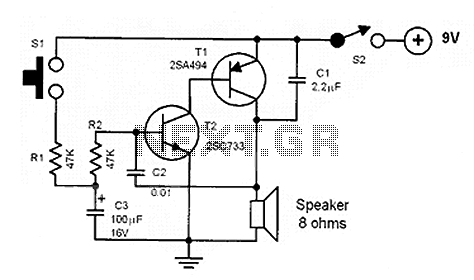
POLICE SIREN USES FLASHER

A low-drain circuit powered by a 1.5-V cell utilizes National LM3909 flasher integrated circuits (ICs) to replicate the "whooper" sounds characteristic of electronic sirens found in some city police cars and ambulances. Two flashers are necessary to create the required rapidly rising and falling modulating voltage. A transistor is configured as a diode to influence the ramp generator of the IC, resulting in longer ON periods compared to OFF periods, which increases the average tone and enhances the evenness of the modulation. -P. Lefferts, Power-Miser Flasher IC Has Many Novel Applications, EDN Magazine, March 20, 1976, p. 59-66.
The described circuit employs the National LM3909 flasher IC, renowned for its low power consumption, making it suitable for battery-operated applications. The circuit operates at a nominal voltage of 1.5 V, which is typical for standard alkaline cells. The use of two LM3909 ICs is essential for achieving the desired audio modulation, as they work in tandem to produce a rapidly oscillating voltage that mimics the sound profile of sirens.
The configuration of the transistor as a diode plays a critical role in shaping the output waveform. By forcing the ramp generator of the LM3909 to maintain longer ON periods, the circuit enhances the average output tone. This is particularly important for creating a sound that is both attention-grabbing and recognizable. The modulation of the output voltage is achieved through the rapid switching of the flashers, which can be controlled by adjusting external components such as resistors and capacitors associated with the ICs.
In practical terms, the circuit may include additional passive components to filter the output and ensure a clean sound profile. Capacitors can smooth out voltage spikes, while resistors can be used to fine-tune the frequency of oscillation. The overall design is compact and efficient, making it suitable for applications where space and power conservation are critical, such as in portable emergency devices.
This circuit exemplifies the innovative use of flasher ICs beyond traditional lighting applications, showcasing their versatility in sound generation and signaling. The integration of simple components to create complex audio effects is a testament to effective circuit design principles in electronics.Low-drain circuit operating from 1. 5-V cell uses National LM3909 flasher ICs to simulate "whooper" sounds of electronic sirens used on some city police cars and ambulances. Two flashers are required for generating required rapidly rising and falling modulating voltage. Transistor is connected as diode to force ramp generator of IC to have longer O N periods than OFF periods, raising average tone and making modulation seem more even. -P. Lefferts, Power-Miser Flasher IC Has Many Novel Applications, EDN Magazine, March 20, 1976, p 59-66. 🔗 External reference
The described circuit employs the National LM3909 flasher IC, renowned for its low power consumption, making it suitable for battery-operated applications. The circuit operates at a nominal voltage of 1.5 V, which is typical for standard alkaline cells. The use of two LM3909 ICs is essential for achieving the desired audio modulation, as they work in tandem to produce a rapidly oscillating voltage that mimics the sound profile of sirens.
The configuration of the transistor as a diode plays a critical role in shaping the output waveform. By forcing the ramp generator of the LM3909 to maintain longer ON periods, the circuit enhances the average output tone. This is particularly important for creating a sound that is both attention-grabbing and recognizable. The modulation of the output voltage is achieved through the rapid switching of the flashers, which can be controlled by adjusting external components such as resistors and capacitors associated with the ICs.
In practical terms, the circuit may include additional passive components to filter the output and ensure a clean sound profile. Capacitors can smooth out voltage spikes, while resistors can be used to fine-tune the frequency of oscillation. The overall design is compact and efficient, making it suitable for applications where space and power conservation are critical, such as in portable emergency devices.
This circuit exemplifies the innovative use of flasher ICs beyond traditional lighting applications, showcasing their versatility in sound generation and signaling. The integration of simple components to create complex audio effects is a testament to effective circuit design principles in electronics.Low-drain circuit operating from 1. 5-V cell uses National LM3909 flasher ICs to simulate "whooper" sounds of electronic sirens used on some city police cars and ambulances. Two flashers are required for generating required rapidly rising and falling modulating voltage. Transistor is connected as diode to force ramp generator of IC to have longer O N periods than OFF periods, raising average tone and making modulation seem more even. -P. Lefferts, Power-Miser Flasher IC Has Many Novel Applications, EDN Magazine, March 20, 1976, p 59-66. 🔗 External reference





